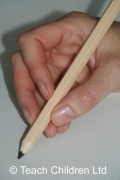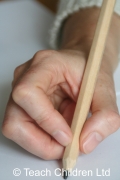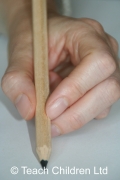Pencil grip development in Key Stage 2
Key Stage 2 (7 - 11 year olds)
The dynamic tripod pencil grip is considered the most appropriate grip for handwriting, for both right and left-handed writers, however not all children find this the easiest grip to learn.
It is important to hold a pencil correctly to allows the fingers and wrist to move freely without putting strain on the hand, helping to improve correct letter formation ability and making handwriting a more comfortable experience.
There are 5 Pencil Grip Developmental Stages on the way to developing a good tripod pencil grip for handwriting.
Year 3 (7 - 8 year olds)
As children move from Key Stage 1 (5 to 7 year olds) to Year 3 they may still be at different pencil grip development stages, this is what we would normally expect:
- A few children will be at Stage 4;
- The majority will have reached Stage 5; some may not be confident in its use but most should be comfortable and naturally using the tripod grip for handwriting.
Year 4 to 6 (8 - 11 year olds)
It would normally be expected for children in Year 4 and upwards to be confident and naturally using the tripod grip for handwriting tasks. For some children who have developed a poor pencil grip, and find it difficult if not near on impossible to change, then developing the adaptive tripod grip may prove to be a more appropriate option (suitable for both left and right-handed writers).
Stage 4 - Static quadruped or tripod grip

Holding the pencil in very nearly the correct position however the web space is narrower than it would be if held in a mature tripod grip. This means that the movement is coming from the wrist and large finger movements.
Stage 5 - Mature / Dynamic tripod grip
Right-
Handed
Left-
Handed

This is traditionally considered the most appropriate handwriting pencil grip for both left and right-handed writers. Holding the pencil between the thumb and index finger with pencil supported on the middle finger. The ring and little fingers are gently curled inwards. This gives an open wide web space which means the movement comes from the fingers.


